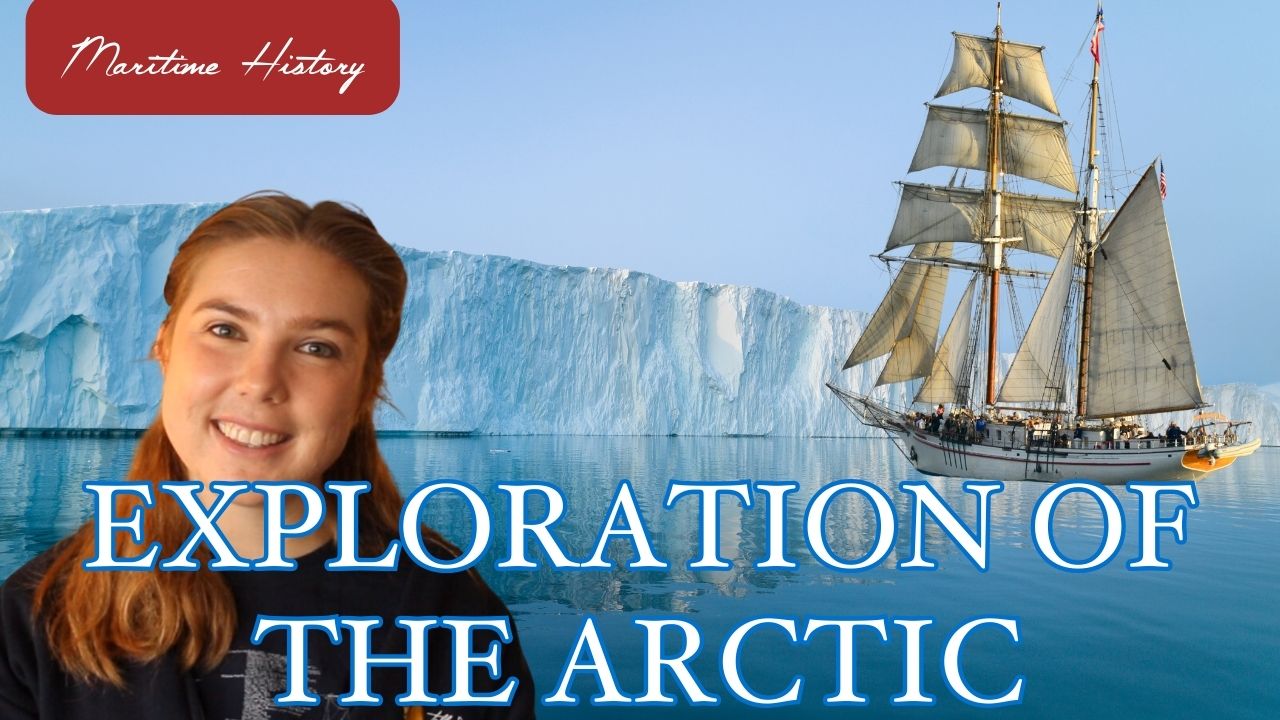
12 Dec English Exploration of the Arctic
This week on #TallShipTuesday we took a trip to the frigid arctic. But what did the 19th century explorers hope to find beyond the 18th parallel? It was a mysterious vast, cold, and dangerous expanse and much speculation about what might be there. Was there a wall of ice and a tropical paradise inside? A secret civilization filled with riches beyond imagination? In discovering literature’s obsession with the arctic, science communicator Katheryn Schulz wrote that there were many speculations on “the theory of the open polar sea. The most ardent supporters of that theory believed in a kind of Nordic El Dorado. Beyond the eightieth parallel, they held, the ocean was not merely ice-free but actually warm, leading to a kind of tropical paradise—possibly complete with a lost civilization— tucked away at the top of the planet.”
Intrepid sailors set sail to conquer the Arctic expanse. They were driven by the desire for discovery and the quest for the Northwest Passage – a fabled route connecting the Atlantic and Pacific oceans.
Early Exploration of the Arctic
In the early 19th century, explorers like Sir John Franklin and Sir William Parry embarked on perilous journeys, facing treacherous ice conditions and bitter cold. Their expeditions laid the groundwork for future Arctic exploration and fueled the imagination of generations to come. A narrative from the exploration ship Blossom describes the influences of these two and others published in 1832:
“[T]he last that sailed upon this interesting service- and the command again conferred upon Captain Parry, whose exploits have so deservedly earned him approbation of his country. At the same time Captain Franklin, undaunted by his former perilous expedition and by the magnitude of the contemplated undertaking, having with the promptness and perseverance peculiar to his character proposed to connect his brilliant discoveries at the mouth of the Coppermine River with the furthest known point on the western side of America… His late Majesty was also pleased to command that this expedition should be simultaneously undertaken.”
Sir William Parry
Sir William Parry, set out on an Arctic expedition in 1819. Parry commanded two 3-masted sailing ships: HMS Hecla and Griper. After several months of sailing, they found they needed to return before winter. They were not prepared to sail in such extreme weather.
“The Crews of the H.M.S. Hecla & Griper cutting into Winter Harbour. Sept. 26th 1819” drawn and engraved by W. Westall from a sketch by Frederick William Beechey
Sir John Franklin
At the same time, Sir John Franklin was chosen to lead the Coppermine Expedition. It was a 3 year journey up north overland from Hudson Bay. The goal of the expedition was to chart the north coast of Canada eastwards from the mouth of the Coppermine River. The expedition went rather poorly, and Franklin lost 11 of 20 in his crew, most of whom died of starvation.
‘View of the Arctic Sea, from the mouth of the Copper Mine River, midnight, July 20 1821’ by midshipman George Back Weather Proofing
Surviving the Weather
The Voyages were perilous. The weather described as incredibly harsh many times in Parry’s recount of his voyage in 1819. He wrote while trapped in Winter Harbor that “the rapidity with which the ice increased in thickness, in proportion as the general temperature of the atmosphere diminished, would have rendered a day’s delay of serious importance… the thermometer was at 6 in the morning, and rose no higher than 9 during the day… the average thickness of the ice was seven inches.”
In the following years, there was another trip to the arctic. And another. Each time the crew learned and grew.
To combat this, explorers and scientists worked together to develop technology to weather the cold. Winter weatherproofing, the use of canning, double doors to maintain heat, melting snow for fresh water, heat ducts that go through the ship to distribute heat, and other innovations all helped make the arctic easier to survive. The next several times they sailed, crews were much better prepared to brave the frigid and dangerous conditions.
The Lost Mission
In 1845 Captain Sir John Franklin departed England, aboard two ships, HMS Erebus and HMS Terror. He was assigned to traverse the last unnavigated sections of the Northwest Passage in the Canadian Arctic. The expedition became icebound in Victoria Strait near King William Island. After being icebound for more than a year Erebus and Terror the crew abandoned them, and before long all of the men, 129 in total, perished.
In the late 19th century, the stories of the lost expedition remained and captured the imagination. Even the likes of great authors such as Sir Arthur Conan Doyle made the voyage on the whaling ship Hope to the arctic. In the frigid silence of the Arctic, the names Sir John Franklin and Sir William Parry echo through time – two men whose expeditions forged a path into the unknown, leaving an indelible mark on the history of exploration.
Citations:
https://www.newyorker.com/magazine/2017/04/24/literatures-arctic-obsession
https://royalsociety.org/blog/2012/04/up-the-coppermine-without-a-paddle/
http://www.newworldexploration.com/explorers-tales-blog/wintering-in-the-arctic
https://archive.org/details/bub_gb_7YcBAAAAYAAJ/page/n15/mode/1up?view=theater
https://library.princeton.edu/visual_materials/maps/websites/northwest-passage/franklin-first.htm
https://www.biodiversitylibrary.org/item/79287#page/11/mode/1up
https://www.rmg.co.uk/stories/topics/what-happened-to-erebus-terror-crew-true-story
https://royalsociety.org/blog/2012/04/up-the-coppermine-without-a-paddle/






Sorry, the comment form is closed at this time.